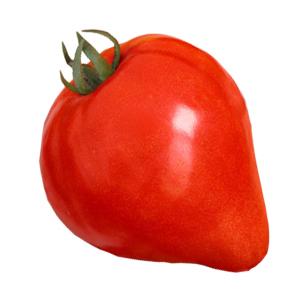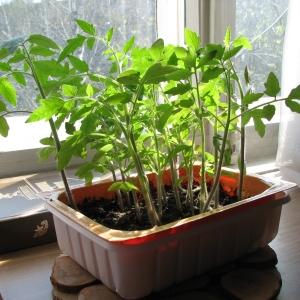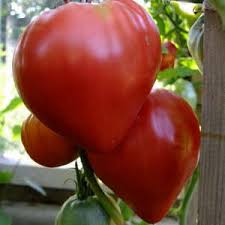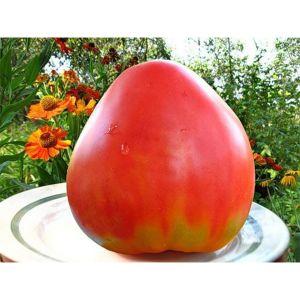A gift to farmers from Russian breeders: the “Velmozha” tomato is an early ripening variety with a bountiful harvest
Tomatoes are rich in vitamins and minerals. They help a person fight depression and improve the functioning of the cardiac system. There are beds with tomatoes in almost every garden.
Vegetables differ from each other in taste and color, care and harvest. Among the variety, the Velmozha variety stands out. Let's consider the detailed characteristics and description of the variety.
Description of the variety
The variety is characterized as productive. Velmozha tomatoes are juicy, moderately sweet. Let us consider in detail the features of this variety.
Distinctive features
Velmozha is a mid-season variety. Suitable for growing both in open ground and in a greenhouse. The bushes are determinant and have limited growth. Maximum height is about 0.8 m. The leaves are light green and medium in size.
The variety is productive and does not require special care. It is popular among gardeners in both the northern and southern regions of the country.
Characteristics of tomatoes and yield
 The fruits are large and fleshy, pink-crimson in color. The size is large, the weight of one tomato reaches 400 g. The shape of the tomato is heart-shaped, oval.
The fruits are large and fleshy, pink-crimson in color. The size is large, the weight of one tomato reaches 400 g. The shape of the tomato is heart-shaped, oval.
The taste is rich, with a predominance of sweetish shades and sugar content. They have a high degree of keeping quality and tolerate transportation well.
Velmozha's productivity is high. With proper care and compliance with all the rules, about 400 centners of large and tasty tomatoes are harvested from 1 hectare in the conditions of the Urals and Siberia.And in the regions in the south of the country - about 700 quintals.
How to grow seedlings
It is the seedlings that influence the quality and quantity of the future harvest.
Seed preparation
It is recommended to read the manufacturer's information on the packaging before purchasing seeds. You can purchase them both through online stores and at any gardening store. Trust only proven and reliable suppliers.
Place the seeds on a flat surface, inspect them, check for any uncharacteristic signs. For example, if several seeds are covered with plaque or have a strange color, it is better to discard them immediately.
The main stage of seed preparation is disinfection. The material is disinfected in several ways. For example, soak in a solution based on hydrogen peroxide. Thanks to this, all infections and pathogens are destroyed.
Then hardening is carried out. To do this, place the seeds in the freezer overnight, then take them out and leave them in the room for the day. By repeating these steps several times, you will increase the plants' resistance to sudden weather changes.
Container and soil
If you bought ready-made soil in a store, you don’t have to worry - it has gone through all disinfection procedures and is unlikely to contain hazardous substances. If you prepared the mixture yourself, then be sure to carry out a number of procedures. First of all, disinfect the soil with boiling water. Place the soil in a pot with drainage holes and pour a small amount of boiling water into it.
Important! You should not start planting immediately after disinfection. Moisten the soil and keep it at above-zero temperatures for 10 days. This time is necessary for the development of beneficial bacteria in the soil. Only then start sowing.
With capacity things are simpler.An excellent option would be wooden boxes or special plastic containers for seedlings. The main thing is that the container is clean and dry.
Sowing
Sowing of seedlings is carried out 60 days before the intended planting in the garden. Fill the containers with slightly damp soil and make holes in it about 1 cm deep.
The distance between the holes should be about 4 cm. Sprinkle the holes with earth on top and pour plenty of warm water.
Cover the top of the container with film or glass. This will provide the seedlings with the necessary microclimate and humidity level. Place the container in a bright and warm place.
Growing and care
 Seedlings need light and warmth. You can place containers with seedlings on the brightest windowsill in the house. If possible, it is recommended to provide the plant with additional light using fluorescent lamps.
Seedlings need light and warmth. You can place containers with seedlings on the brightest windowsill in the house. If possible, it is recommended to provide the plant with additional light using fluorescent lamps.
Young shoots should always be kept in a moist environment; drying out is unacceptable. It is recommended to remove the film or glass only after 2 weeks from the date of planting. Before this, you should only open it a little so that the seedlings get used to the light and warmth.
2 weeks after the appearance of the first shoots, carry out the first fertilizing. Mineral and organic fertilizers based on manure or grass are ideal. In the future, fertilize every week.
Read also:
Why do you love tomatoes from the “Peach” series?
The most delicious tomato for lovers of large fruits: the “King of Giants” tomato.
Top 25 sweetest varieties of tomatoes and tips on choosing them for every gardener.
How to grow tomatoes
A cool, windless day is ideal for planting the plant in the ground. In order for the sprouts to take root in the ground, we advise you to follow some rules.
Landing
Prepare the beds well in advance of planting.To do this, collect all the garbage, branches, remains of old plants and burn them. Be sure to disinfect the soil (for example, with a solution of potassium permanganate).
Once the beds are completely ready, make holes in them and place a sprout in each. The optimal distance between plants is about 40 cm. Water the planted seedlings generously. However, be careful to direct the water stream so that it does not hit the leaves.
Care
Plants need regular loosening of the soil. The operation must be performed every 5-7 days. Loosening saturates the soil with oxygen, making it even more nutritious for tomatoes. At the stage of ovary formation, be sure to remove weeds, otherwise the latter will feed on the tomatoes.
 Plays a significant role in the development of the bush watering. It must be balanced: you should not create a swamp in the beds or, conversely, keep them dry. The Grandee needs to be watered every 5-6 days. The water temperature must be at least 22 degrees.
Plays a significant role in the development of the bush watering. It must be balanced: you should not create a swamp in the beds or, conversely, keep them dry. The Grandee needs to be watered every 5-6 days. The water temperature must be at least 22 degrees.
Since Velmozha produces additional shoots during flowering, pay special attention to pinching. Remove stepchildren carefully, without harming the main stem. Also, due to the large size and heavy weight of the fruits, it is necessary to tie the clusters to the stem. Otherwise they may break.
Important! Don't forget about fertilizing. Start feeding the Nobleman from the moment the first ovary forms. Wood ash, liquid mullein, and superphosphate are excellent fertilizers.
Features of cultivation and possible difficulties
The Velmozha variety needs the formation of bushes. Most often, one main stem is left. All formed stepsons are removed from it. The first step is to eliminate those that appeared immediately under the brushes, otherwise the plant may drop its flowers and die. In this case, the stepsons should not be pulled out, but broken off. If the shoots are longer than 5 cm, remove them using garden shears.
The nobleman needs to be groomed constantly. If the summer turns out to be too hot, then be especially careful when removing the stepsons, since in the heat the plant does not tolerate any injury well. If the summer is cool and rainy, then in addition to the stepsons, it is necessary to remove all the lower leaves. This way the bushes will warm up faster and be better ventilated.
Important! For the best harvest in mid-August, pinch the tops of the bushes and remove any trusses on which the tomatoes have not set. Thanks to this, already ripening fruits will quickly gain color and taste.
Diseases and pests
The variety has strong immunity, but is sometimes affected by brown spots in greenhouses. They are combated by eliminating excess moisture and correct light conditions. In addition, it is recommended to spray the bushes with garlic infusion.
 In open ground, Velmozha is sometimes attacked by spider mites. This insect eats leaves and stems, causing the bushes to die. To combat spider mites, treat the bushes with a soap solution.
In open ground, Velmozha is sometimes attacked by spider mites. This insect eats leaves and stems, causing the bushes to die. To combat spider mites, treat the bushes with a soap solution.
Particular attention is paid to protecting the bush from late blight. This is a fungal infection that can destroy most of the crop. The fungal spore penetrates the stem through the stomata and infects the remaining leaves.
It appears as a white coating or brown-yellow spots. They fight late blight with a solution of potassium permanganate or an infusion based on tobacco leaves.
Experienced gardeners advise carrying out preventive measures before planting.It is better to worry about the future harvest in advance than to wait for the onset of disease.
The nuances of growing in open ground and in a greenhouse
When growing tomatoes in open ground, it is recommended to add an ash solution to the water during watering. This will improve the immunity of tomatoes and give additional strength for growth. It is also recommended to loosen the soil every time you notice a hard crust on it.
In open ground conditions, bushes need to be fed constantly. Ammonium nitrate or potassium chloride are suitable for this. Gardeners recommend using magnesium and boron as microfertilizers. Magnesium is used constantly, and boron is used only when the plant blooms.
When growing Nobleman in a greenhouse, do not forget to ventilate the room. It has an increased level of moisture, and therefore a favorable atmosphere for the development of microbes. Before planting, disinfect not only the ground, but also all hard surfaces - pegs, doors, walls of the greenhouse.
Add a layer of straw and grass clippings to the greenhouse throughout the season. This prevents the development of late blight. The presence of earthworms also affects the health of the soil.
Harvesting and application
The ripening period of the variety varies from 105 to 120 days. The fruits ripen gradually, so you will enjoy the Nobleman for several weeks. Harvest vegetables when they reach the intended size. For long-term storage, Velmozha is collected together with the substrate. Tomatoes are able to ripen after picking, at room conditions. Their keeping quality is high.
 Velmozhi fruits are universal in use. Their juicy and sweet taste makes them great for salads, soups and side dishes. Serve as an excellent addition to meat, fish and poultry dishes.
Velmozhi fruits are universal in use. Their juicy and sweet taste makes them great for salads, soups and side dishes. Serve as an excellent addition to meat, fish and poultry dishes.
The only exception is preparing preparations for the winter. Large and heavy tomatoes do not fit entirely into a jar, so smaller tomatoes are better suited for canning.
Due to the high content of beneficial vitamins and microelements, Velmozha is suitable for dietary and baby food. It contains B vitamins, magnesium, calcium, and serves as a natural antioxidant.
Many people also use tomato as a cosmetic product. For example, they make a face mask from a mixture of cottage cheese and tomato.
Advantages and disadvantages of the variety
The advantages of the Velmozha variety are as follows:
- juicy and bright taste;
- high productivity;
- versatility in application;
- the opportunity to grow tomatoes not only in the southern, but also in the northern regions of the country;
- good shelf life;
- immunity to transportation.
Minuses:
- needs gartering and pinching;
- average immunity to diseases and pests;
- To obtain a rich harvest, fertilizing is necessary;
- not suitable for whole canning and pickling.
Farmer reviews
The opinions of gardeners regarding the Velmozha tomato are ambiguous.
Victoria, Orenburg region: “I have loved tomatoes since childhood. As soon as I had my own garden, I immediately planted tomatoes in it. The choice fell on the Velmozha variety. Manufacturers promised large tomatoes with a juicy taste. In fact, the maximum weight of my tomatoes reached 170 g. I don’t know what’s the matter, why they turned out to be so small. I'll try to grow them again next year. I’ll probably already plant it in the greenhouse.”
Olga, Kostroma region: “I’ve been imprisoning the nobleman since 2011. My family and I love it very much, especially in the form of tomato juice. I like the sweet taste of tomato.I recommend growing Velmozha to all my neighbors in the garden.”
Vadim, Republic of Tatarstan: “As an experienced gardener, I can say that Velmozha is a high-quality and tasty tomato. In addition, it is not difficult to care for. In all the time I’ve been growing it, the tomato has never gotten sick.”
Conclusion
Heart-shaped sweet tomatoes of the Velmozha variety are good both fresh and after heat treatment. The vegetable is used to make juice, ketchup, lecho and much more. Some even use it as a main product for making jam. Large, beautiful fruits also look impressive sliced on a holiday table.
The most important thing in care is to observe the light regime and watering order, and remove the stepsons in a timely manner. Do this carefully so as not to damage the main stem. The Velmozha tomato stores well and can be transported over long distances.